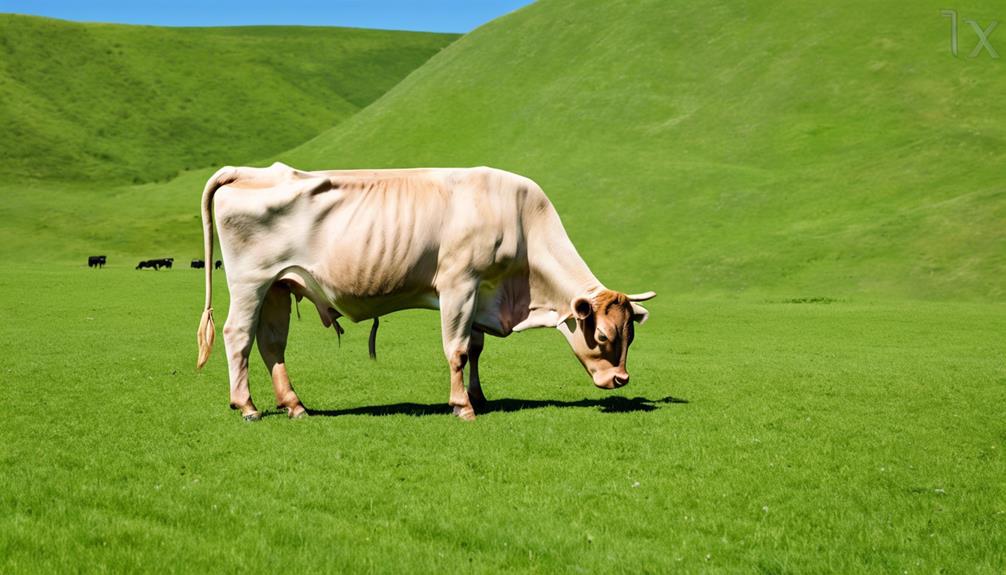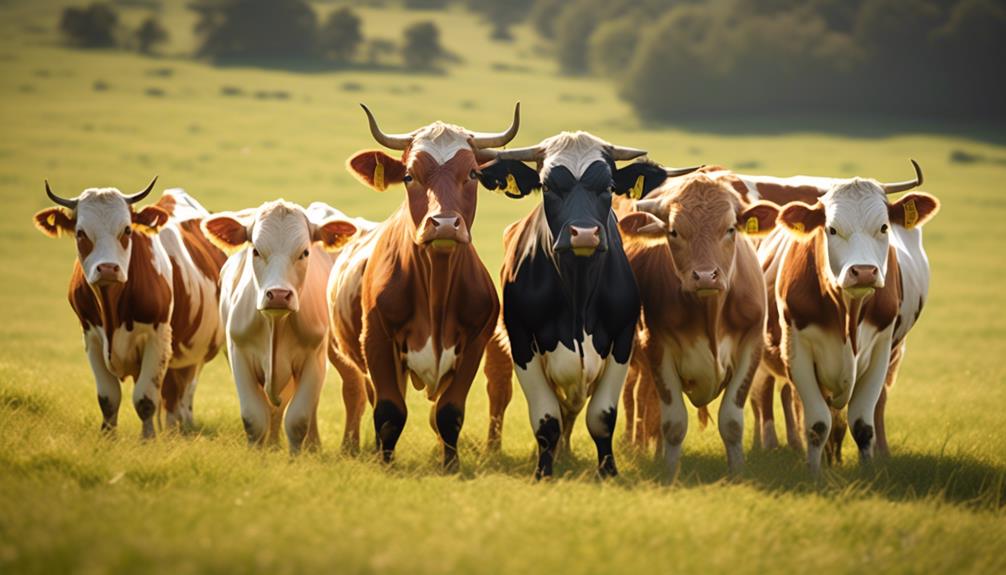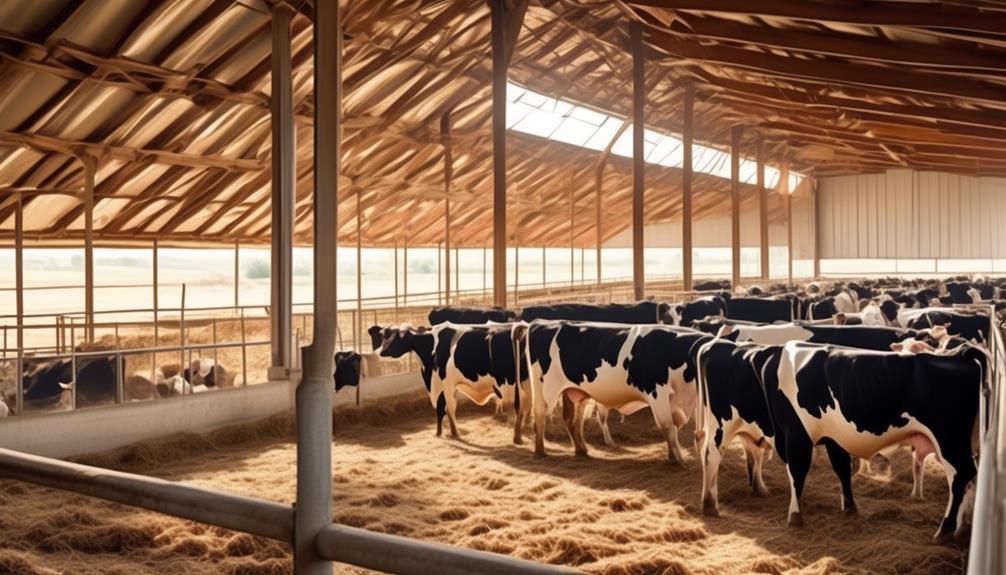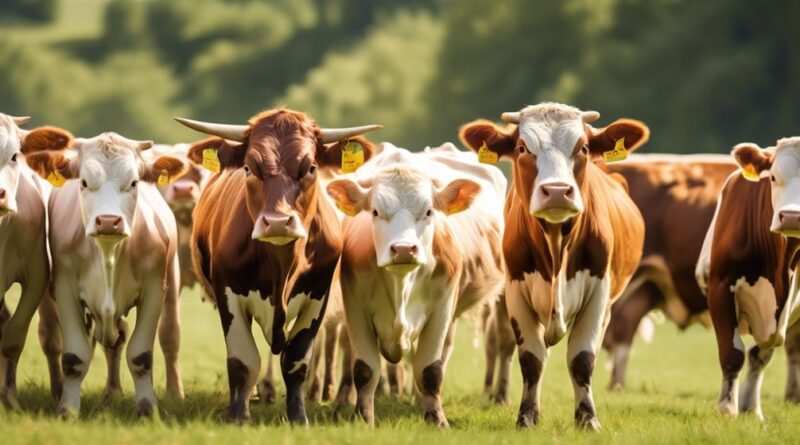Improving Pregnancy Success in Cattle: 8 Essential Strategies
You may not realize it, but improving pregnancy success in your cattle can significantly impact your bottom line. By implementing eight essential strategies, you can enhance the reproductive efficiency of your herd and ultimately increase your profitability.
From nutrition management to genetic selection, each aspect plays a crucial role in ensuring successful pregnancies in your cattle. But what are these strategies, and how can they benefit your operation?
Let's explore each one in detail to help you optimize your cattle's reproductive performance and overall herd health.
Nutrition Management

To improve pregnancy success in cattle, it's crucial to carefully manage their nutrition, ensuring they receive the right balance of nutrients at each stage of their reproductive cycle. Feed quality plays a pivotal role in the overall health and reproductive success of cattle. Providing high-quality feed that's free from molds, toxins, and contaminants is essential for supporting optimal reproductive function. Ensuring that the feed is rich in essential nutrients such as protein, energy, vitamins, and minerals is vital for supporting the cow's reproductive health.
Mineral supplementation is another key aspect of nutrition management in cattle. Minerals like calcium, phosphorus, magnesium, and zinc are crucial for maintaining reproductive health. Deficiencies in these minerals can lead to reproductive issues and lower pregnancy rates. Providing access to mineral supplements or fortified feed can help ensure that the cattle receive the necessary minerals to support their reproductive processes.
When managing the nutrition of cattle for improved pregnancy success, it's important to work closely with a veterinarian or animal nutritionist to develop a comprehensive feeding program that meets the specific needs of the herd. Regular monitoring, adjustment of feed rations, and ensuring access to clean water are also essential components of nutrition management for reproductive success in cattle.
Breeding Program
Developing a strategic breeding program is essential for maximizing pregnancy success in cattle. A well-planned breeding program can significantly improve breeding efficiency and reproductive performance in your herd. Here are some key strategies to consider for enhancing your breeding program:
- Genetic Selection: Carefully select bulls with superior genetic traits such as fertility, calving ease, and disease resistance to improve the overall reproductive performance of your herd. Additionally, consider using artificial insemination (AI) to introduce high-quality genetics and optimize breeding efficiency.
- Estrus Synchronization: Implementing an estrus synchronization program can help ensure that a larger proportion of your herd is bred within a concentrated time frame. This can lead to more uniform calf crops and better reproductive performance across your herd.
- Health and Nutrition Management: Ensuring that your cattle are in optimal health and nutrition is crucial for successful breeding. Proper vaccination protocols, parasite control, and a well-balanced diet can positively impact reproductive performance and breeding efficiency.
Health and Disease Prevention

Ensuring the optimal health and disease prevention measures for your cattle is paramount to maintaining the reproductive performance and breeding efficiency achieved through a strategic breeding program. Vaccination schedules play a crucial role in preventing infectious diseases that can negatively impact pregnancy success. It's essential to work with your veterinarian to establish a comprehensive vaccination program tailored to your herd's specific needs. Regular vaccinations for diseases such as bovine viral diarrhea (BVD), infectious bovine rhinotracheitis (IBR), and leptospirosis can significantly reduce the risk of reproductive disorders and improve overall herd health.
In addition to vaccinations, effective parasite control is vital for maintaining the well-being of your cattle. Internal parasites such as worms can lead to reduced fertility and pregnancy rates. Implementing a strategic parasite control program that includes regular deworming and pasture management is essential for minimizing the impact of parasites on reproductive success.
Regular herd health evaluations and testing can also aid in identifying and addressing potential health issues before they affect breeding outcomes. By monitoring the overall health status of your cattle and promptly addressing any concerns, you can help ensure that your herd remains in optimal reproductive condition.
Reproductive Monitoring
Regularly monitoring the reproductive performance of your cattle is essential for identifying any potential issues and maximizing breeding success. By implementing the following strategies, you can effectively track and manage the reproductive health of your cattle:
- Hormone levels: Monitoring hormone levels in your cattle can provide valuable insights into their reproductive health. Changes in hormone levels can indicate the onset of estrus, pregnancy, or potential reproductive disorders. By regularly testing and tracking hormone levels, you can ensure that your cattle are in optimal breeding condition and address any hormonal imbalances promptly.
- Ultrasound technology: Utilizing ultrasound technology allows you to assess the reproductive status of your cattle non-invasively. This technology enables you to monitor the development of ovarian structures, detect pregnancy, and diagnose reproductive abnormalities. By incorporating regular ultrasound examinations into your reproductive monitoring program, you can gain a deeper understanding of your cattle's reproductive health and make informed breeding decisions.
- Reproductive performance analysis: Tracking and analyzing the reproductive performance of individual animals and the herd as a whole can provide valuable data for optimizing breeding strategies. By documenting breeding outcomes, calving intervals, and fertility rates, you can identify trends and patterns that may require intervention or adjustment. This data-driven approach enables you to make informed decisions to improve the overall reproductive success of your cattle.
These strategies, when combined with regular veterinary consultations, can significantly enhance the reproductive monitoring process and contribute to the overall success of your cattle breeding program.
Environmental Considerations

To optimize pregnancy success in cattle, consider the impact of environmental factors on their reproductive health and breeding outcomes. Climate control plays a crucial role in ensuring optimal conditions for successful breeding. Extreme temperatures can negatively affect fertility in both bulls and cows.
In hot climates, heat stress can lead to reduced sperm quality in bulls and disrupted estrous cycles in cows, decreasing the chances of successful breeding. Conversely, in cold environments, cattle may experience reproductive challenges due to harsh weather conditions. Therefore, it's essential to implement climate control measures such as providing shade, ventilation, and access to clean water to mitigate the effects of extreme temperatures on cattle reproduction.
In addition to climate control, pasture management is another critical aspect of optimizing pregnancy success in cattle. The quality of pasture directly impacts the nutritional intake of the cattle, which is vital for reproductive health. Proper pasture management involves rotational grazing, maintaining optimal forage quality, and ensuring adequate access to essential nutrients.
Genetic Selection
You can enhance pregnancy success in cattle by carefully selecting for desirable genetic traits that contribute to reproductive efficiency and overall herd productivity. Genetic selection plays a crucial role in improving the fertility and productivity of cattle herds. By focusing on selective breeding and genetic improvement, you can significantly impact the overall reproductive success of your cattle.
- Selective Breeding: By identifying and mating animals with superior reproductive traits, you can gradually improve the fertility and pregnancy success rates within your herd. Selective breeding allows you to emphasize specific traits that are essential for reproductive efficiency, such as calving ease, maternal instinct, and overall fertility.
- Genetic Improvement: Utilizing advanced genetic technologies and tools, you can make informed decisions to enhance the genetic makeup of your herd. This can involve leveraging genetic data and information to identify animals with the most desirable reproductive traits and incorporating them into your breeding program to drive continuous improvement.
- Breeding Goals: Establishing clear breeding goals is essential for guiding your genetic selection process. Whether your focus is on increasing conception rates, reducing calving difficulties, or improving overall reproductive performance, defining specific breeding goals will help you make targeted decisions to achieve the desired outcomes.
In addition to these strategies, considering genetic diversity within your herd is pivotal to maintaining a healthy and robust breeding population. By incorporating these genetic selection practices, you can work towards achieving higher pregnancy success rates and overall reproductive efficiency in your cattle herd.
Handling and Stress Reduction

Implement effective handling techniques to minimize stress and ensure optimal reproductive outcomes for your cattle herd. Behavior modification and calming techniques are essential for reducing stress in your cattle, especially during critical reproductive periods. By understanding and working with the natural behavior of cattle, you can minimize stress and create a more conducive environment for successful pregnancies.
When handling your cattle, it's crucial to use low-stress methods that promote calm and cooperative behavior. Sudden movements, loud noises, and rough handling can all contribute to increased stress levels. Instead, focus on gentle, deliberate movements and use quiet, reassuring vocal cues to help keep your cattle relaxed. Additionally, providing a consistent and familiar handling routine can help reduce anxiety and make the cattle more receptive to reproductive activities.
Furthermore, consider implementing behavior modification techniques to help your cattle become more accustomed to handling and human interaction. This can include gradual desensitization to common stressors, such as handling equipment or transportation, through positive reinforcement and rewards. By slowly acclimating your cattle to potentially stressful situations, you can help them remain calmer and more cooperative during critical reproductive procedures.
Incorporating calming techniques, such as providing access to low-stress handling facilities and ample space for movement, can further contribute to reducing stress and improving overall reproductive success. Creating a quiet and comfortable environment for your cattle won't only benefit their well-being but also enhance their reproductive performance. By prioritizing effective handling and stress reduction strategies, you can greatly increase the likelihood of successful pregnancies within your cattle herd.
Professional Consultation
Seeking professional consultation can provide valuable insights and expertise to optimize the reproductive success of your cattle herd. When it comes to improving pregnancy rates in your cattle, consulting with professionals can make a significant difference. Here are some key reasons why professional consultation is crucial:
- Fertility Evaluation: A professional consultation can involve a thorough fertility evaluation of your cattle. This evaluation can help identify any underlying reproductive issues or challenges that may be hindering the success of your herd. By understanding the specific fertility status of your cattle, targeted strategies can be implemented to address any concerns and improve overall reproductive outcomes.
- Hormone Therapy: Professional consultation can also offer guidance on hormone therapy for your cattle. Hormonal imbalances can significantly impact fertility, and a consultation with experts can help determine whether hormone therapy is necessary to enhance reproductive performance. Whether it's optimizing estrous synchronization or addressing specific hormonal deficiencies, professional input can ensure that hormone therapy is tailored to the unique needs of your cattle.
- Customized Reproductive Management Plans: Professional consultation allows for the development of customized reproductive management plans. These plans can encompass various strategies, including optimizing nutrition, implementing effective breeding protocols, and integrating advanced reproductive technologies. By collaborating with professionals, you can create a tailored roadmap to enhance the pregnancy success of your cattle herd.
Professional consultation offers the expertise and support needed to address fertility evaluation, hormone therapy, and customized reproductive management plans, ultimately maximizing the reproductive potential of your cattle.
Frequently Asked Questions
How Can I Ensure That My Cattle Receive Enough Sunlight and Fresh Air in Their Environment to Improve Pregnancy Success?
To ensure your cattle receive enough sunlight and fresh air, prioritize their environment. Implement good environmental management by providing ample sunlight and ventilation, which can positively impact fertility and pregnancy success in your cattle.
What Are Some Common Mistakes in Genetic Selection That Can Impact Pregnancy Success in Cattle?
When selecting genetics for your cattle, common mistakes like overlooking pregnancy success can impact your herd. Consider genetic traits that support fertility and ensure a favorable cattle environment for optimal pregnancy success.
How Can I Minimize Stress During Transportation and Handling to Improve Pregnancy Rates in My Cattle?
To minimize stress and improve pregnancy rates in your cattle, focus on gentle handling techniques, use low-stress transportation methods, and create favorable environmental conditions. These proactive steps can help reduce the negative impact of stress on your herd.
What Are Some Signs of Potential Reproductive Issues That May Not Be Caught Through Regular Reproductive Monitoring?
You might notice hormonal imbalances or nutritional deficiencies leading to reproductive abnormalities. Keep an eye out for behavioral changes like decreased activity or altered feeding patterns, which could signal potential reproductive issues.
What Are Some Unique Challenges That Can Arise in Professional Consultation for Improving Pregnancy Success in Cattle?
When seeking professional consultation for improving pregnancy success in cattle, you'll face unique challenges like balancing nutritional requirements, managing environmental factors, and addressing reproductive management issues effectively. It's a complex but crucial process.
Conclusion
In conclusion, implementing these essential strategies can greatly improve pregnancy success in cattle.
By focusing on nutrition management, breeding programs, health and disease prevention, reproductive monitoring, environmental considerations, genetic selection, handling and stress reduction, and seeking professional consultation, you can ensure the health and fertility of your herd.
With careful attention to these factors, you can increase the likelihood of successful pregnancies and ultimately improve the overall productivity of your cattle operation.
